-
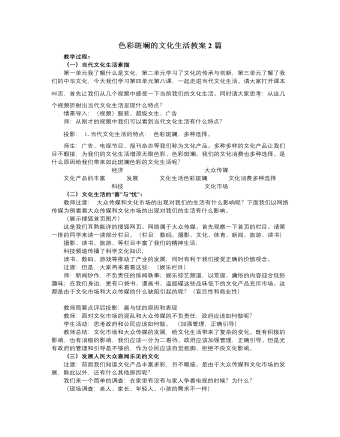
人教版高中政治必修3色彩斑斓的文化生活教案2篇
六、学习效果评价设计1、评价方式:我对学习效果的评价,来自两个方面。一是教师的教授是否认真、严肃、科学;二是学生的学习成果如何,是否达成了事先预设的教学目标,是否在学习过程中有提高的过程。评价的方式有:同伴评价;教师自我评价和反思;学生反馈。2、评价量规:我设置了几个问题用于课后的教学评价:(1)教学目标是否符合课标要求,是否符合三贴近原则,是否体现学生学习效果的生成性和过程性。(2)学习所用资源是否来自生活实际,是否真实,是否是学生感兴趣的问题。(3)教师在课堂教学过程中是否能有效的通过提问和资料的展示分析,引导学生自己生成思考过程,而不是“教师代替学生的思考”。(4)学生参与的广度和态度,学生是否提出有意义的观点和问题。学生的回答是否是实话。
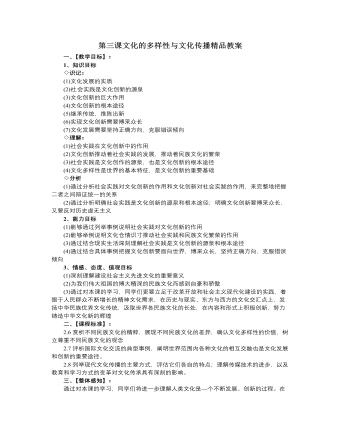
人教版高中政治必修3第三课文化的多样性与文化传播精品教案
◇探究提示:我们可以通过人际交往,阅读报纸、杂志、书籍等,欣赏电视、上网查询、发送手机短信、阅读电子读物等方式来搜集资料。其特点为:人际传播是社会生活中最直观、最常见、最丰富的传播现象,具有传播渠道多、方法灵活、意义丰富、反馈及时的特点。报纸、杂志、书籍等,可以通过扫描、编排处理后,显示在互联网上,供广大读者使用。电视提供了动态画面和缤纷的色彩,使人们对信息的理解变得更生动、形象和真实。互联网具有传播同网、全球同时、受众主动、双向互动的特点。手机短信用精练的语言传达丰富多彩的内容,不仅具有娱乐性,还具有情感性、艺术性耙哲理性,让人回味无穷。电子读物实现了文字、图像、声音的完关结合,使人在看图阅文的同时可以听音乐、写文章、做笔记、复制文件等等。

人教版高中政治必修3第四课文化的继承性与文化发展精品教案
◇探究提示:(1)孔子思想体系的核心是“仁’’和“礼”,其主要内容是“仁者爱人”和“克己复礼”。孔子提出“仁”的学说,要求统治者体察民情,反对苛政和任意刑杀;提倡广泛地理解、体贴他人,以此调整人际关系,稳定社会秩序。孔子讲的“克己复礼”,是说做人要克制自己,使自己的行为符合‘‘礼’’的要求。(2)老子认为“道”是凌驾于天之上的天地万物的本原,他提出‘‘天法道,道法自然”的思想。老子从“天道自然无为”的思想出发,倡导政治上“无为而治”,以“无事取天下”。老子哲学中包含着丰富的辩证法思想,他指出,任何事物都有矛盾、对立的两个方面,矛盾双方可以相互转化。(3)墨子主张“兼爱”“非攻”,“兼爱”就是无等差的爱,无论任何人,都不分轻重厚薄;“非攻”就是反对不义的兼并战争,主张各国和平相处。(4)韩非子崇尚法,强调法的重要性,主张法、术、势相结合,建立一个君主专制的中央集权国家,要求人人必须遵守法;韩非子还认为社会不断发展变化,历史永远不会倒退,主张变法革新。
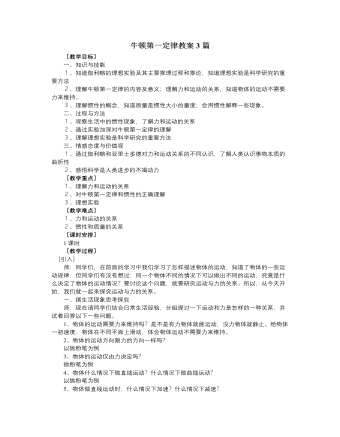
人教版新课标高中物理必修1牛顿第一定律教案3篇
一、知识与技能1、知道伽利略的理想实验及其主要推理过程和推论,知道理想实验是科学研究的重要方法2、理解牛顿第一定律的内容及意义;理解力和运动的关系,知道物体的运动不需要力来维持。3、理解惯性的概念,知道质量是惯性大小的量度;会用惯性解释一些现象。二、过程与方法1、观察生活中的惯性现象,了解力和运动的关系2、通过实验加深对牛顿第一定律的理解3、理解理想实验是科学研究的重要方法三、情感态度与价值观1、通过伽利略和亚里士多德对力和运动关系的不同认识,了解人类认识事物本质的曲折性2、感悟科学是人类进步的不竭动力[教学重点]1、理解力和运动的关系2、对牛顿第一定律和惯性的正确理解3、理想实验[教学难点]1、力和运动的关系2、惯性和质量的关系[课时安排]1课时[教学过程][引入]
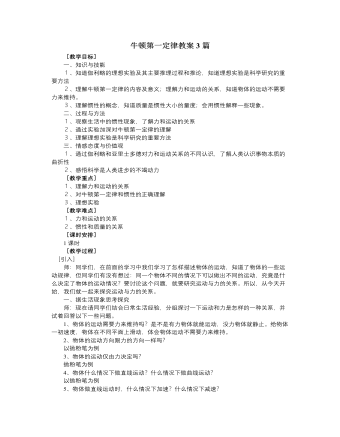
人教版新课标高中物理必修1牛顿第一定律教案3篇
一、知识与技能1、知道伽利略的理想实验及其主要推理过程和推论,知道理想实验是科学研究的重要方法2、理解牛顿第一定律的内容及意义;理解力和运动的关系,知道物体的运动不需要力来维持。3、理解惯性的概念,知道质量是惯性大小的量度;会用惯性解释一些现象。二、过程与方法1、观察生活中的惯性现象,了解力和运动的关系2、通过实验加深对牛顿第一定律的理解3、理解理想实验是科学研究的重要方法三、情感态度与价值观1、通过伽利略和亚里士多德对力和运动关系的不同认识,了解人类认识事物本质的曲折性2、感悟科学是人类进步的不竭动力[教学重点]1、理解力和运动的关系2、对牛顿第一定律和惯性的正确理解3、理想实验[教学难点]1、力和运动的关系2、惯性和质量的关系
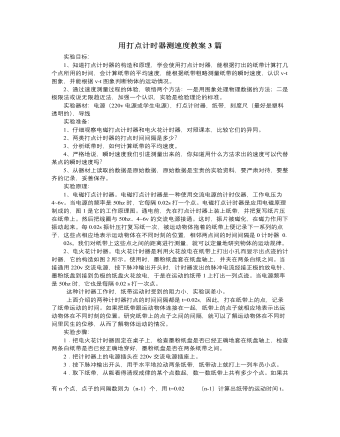
人教版新课标高中物理必修1用打点计时器测速度教案3篇
实验目标:1、知道打点计时器的构造和原理,学会使用打点计时器,能根据打出的纸带计算打几个点所用的时间,会计算纸带的平均速度,能根据纸带粗略测量纸带的瞬时速度,认识v-t图象,并能根据v-t图象判断物体的运动情况。2、通过速度测量过程的体验,领悟两个方法:一是用图象处理物理数据的方法;二是极限法或说无限趋近法,加强一个认识,实验是检验理论的标准。实验器材:电源(220v电源或学生电源),打点计时器,纸带,刻度尺(最好是塑料透明的),导线实验准备:1、仔细观察电磁打点计时器和电火花计时器,对照课本,比较它们的异同。2、两类打点计时器的打点时间间隔是多少?3、分析纸带时,如何计算纸带的平均速度。4、严格地说,瞬时速度我们引进测量出来的,你知道用什么方法求出的速度可以代替某点的瞬时速度吗?
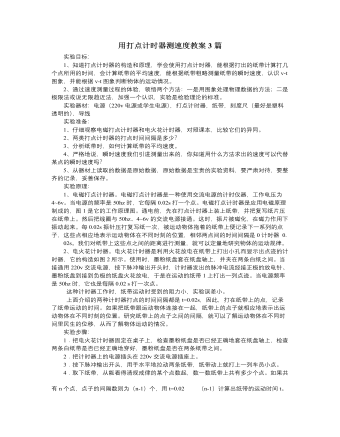
人教版新课标高中物理必修1用打点计时器测速度教案3篇
实验目标:1、知道打点计时器的构造和原理,学会使用打点计时器,能根据打出的纸带计算打几个点所用的时间,会计算纸带的平均速度,能根据纸带粗略测量纸带的瞬时速度,认识v-t图象,并能根据v-t图象判断物体的运动情况。2、通过速度测量过程的体验,领悟两个方法:一是用图象处理物理数据的方法;二是极限法或说无限趋近法,加强一个认识,实验是检验理论的标准。实验器材:电源(220v电源或学生电源),打点计时器,纸带,刻度尺(最好是塑料透明的),导线实验准备:1、仔细观察电磁打点计时器和电火花计时器,对照课本,比较它们的异同。2、两类打点计时器的打点时间间隔是多少?3、分析纸带时,如何计算纸带的平均速度。4、严格地说,瞬时速度我们引进测量出来的,你知道用什么方法求出的速度可以代替某点的瞬时速度吗?5、从器材上读取的数据是原始数据,原始数据是宝贵的实验资料,要严肃对待,要整齐的记录,妥善保存。
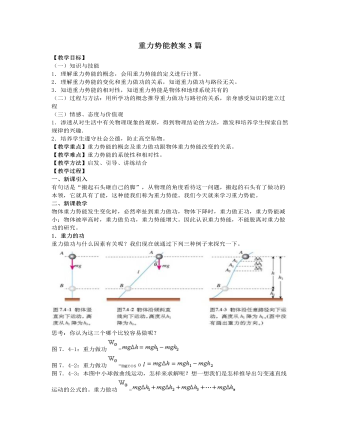
人教版新课标高中物理必修2重力势能教案3篇
(一)知识与技能1.理解重力势能的概念,会用重力势能的定义进行计算。2.理解重力势能的变化和重力做功的关系,知道重力做功与路径无关。3.知道重力势能的相对性,知道重力势能是物体和地球系统共有的(二)过程与方法:用所学功的概念推导重力做功与路径的关系,亲身感受知识的建立过程(三)情感、态度与价值观1.渗透从对生活中有关物理现象的观察,得到物理结论的方法,激发和培养学生探索自然规律的兴趣.2.培养学生遵守社会公德,防止高空坠物。【教学重点】重力势能的概念及重力做功跟物体重力势能改变的关系。【教学难点】重力势能的系统性和相对性。【教学方法】启发、引导、讲练结合【教学过程】一、新课引入有句话是“搬起石头砸自己的脚”,从物理的角度看待这一问题,搬起的石头有了做功的本领,它就具有了能,这种能我们称为重力势能。我们今天就来学习重力势能。二、新课教学
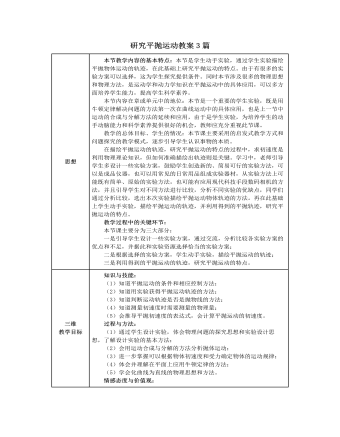
人教版新课标高中物理必修2研究平抛运动教案3篇
(给出仪器后先让学生思考如何设计实验、安装仪器、设计实验步骤,而后教师总结)实验步骤如下:①安装调整斜槽 :用图钉把白纸钉在竖直板上,在木板的左上角固定斜槽。②调整木板 :用悬挂在槽口的重锤线把木板调整到竖直方向,并使木板平面与小球下落的竖直面平行,然后把重锤线方向记录到钉在木板上的白纸上,固定木板,使在重复实验的过程中,木板与斜槽的相对位置保持不变。③确定坐标原点:把小球放在槽口处,用铅笔记下小球在槽口时球心在木板上的水平投影点O,O即为坐标原点。④描绘运动轨迹 :用铅笔的笔尖轻轻地靠在木板的平面上,不断调整笔尖的位置,使从斜槽上滚下的小球正好碰到笔尖,然后就用铅笔在该处白纸上点上一个黑点,这就记下了小球球心所对应的位置。保证小球每次从槽上开始滚下的位置都相同,用同样的方法可找出小球平抛轨迹上的一系列位置。取下白纸,描绘小球做平抛运动的轨迹。
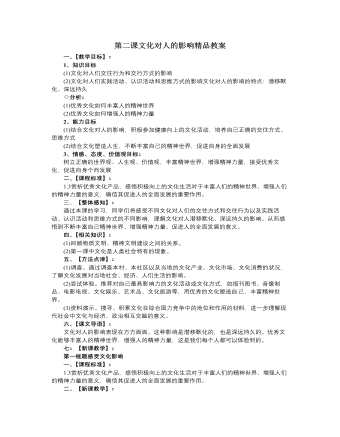
人教版高中政治必修3第二课文化对人的影响精品教案
民族精神是一个民族赖以生存和发展的精神支撑。一个民族,没有振奋的精神和高尚的品格,不可能自立于世界民族之林。“铁人”精神是“爱国、创业、求实、奉献”的大庆精神的典型化、人格化。其主要方面包括:“为祖国分忧、为民族争气”的爱国主义精神;为“早日把中国石油落后的帽子甩到太平洋里去”,“宁肯少活二十年,拼命也要拿下大油田”的忘我拼搏精神;干事业“有条件要上,没有条件创造条件也要上”的艰苦奋斗精神;“要为油田负责一辈子”,“干工作要经得起子孙万代检查”,对工作精益求精,为革命“练一身硬功夫、真本事”的科学求实精神;不计名利,不计报酬,埋头苦干的“老黄牛”精神;等等。40多年来,“铁人”精神早已家喻户晓,深入人心,成为大庆人的共同理想、信念和行为准则。“铁人”精神是对王进喜崇高思想、优秀品德的高度概括,体现了我国工人阶级精神风貌和中华民族传统美德的完美结合。“铁人”精神是战胜困难、勇往直前、不断取得新胜利的巨大精神力量。“铁人”精神是我们强大的精神支柱。
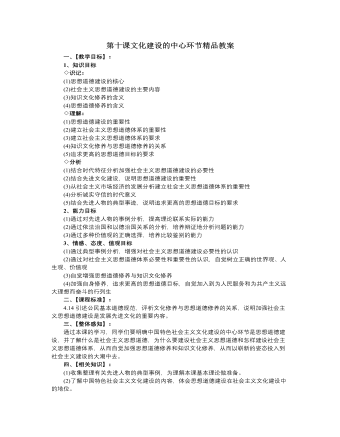
人教版高中政治必修3第十课文化建设的中心环节精品教案
1、追求更高的思想道德目标的要求(1)在遵守公民基本道德规范的基础上,追求更高的思想道德目标,是一个不断改造主观世界的长期过程。积极的、健康的、进步的思想道德,总是旧消极的、有害的、落后的思想道德相比较而存存、相斗争而发展的。只有形成正确的世界观、人生观、价值观,真正划清唯物论与唯心论的界限,社会主义心想与封建主义、资本主义腐朽思想的界限,科学与迷信的界限,文明与愚昧的界限、才能切实增强识别和抵制各种错误思潮的能力,为此,必须努力学习马克思主义的科学理论,坚定建没小闻特色社会主义共同理想,逐步树立共产主义远大理想。◇点拨:“专家点评”说明了共同理想与最高理想的关系。(1)共同理想和最高理想的区别:含义不同。根据马克思主义的科学预见,共产主义社会将是物质财富极大丰富、人民精神境界极大提高,每个人自由而全面发展的社会。
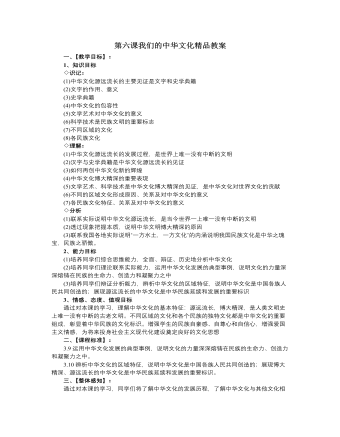
人教版高中政治必修3第六课我们的中华文化精品教案
(三)、中华之瑰宝.民族之骄傲1.我国各具特色的民族文化异彩纷呈.都为中华文化的形成和发展做出了重要贡献(1)我国的雕刎建筑艺术是各族人民共同创造的,都是中华文化的瑰宝。例如:敦煌石窟、云冈石窟;克孜尔千佛洞等,是古代的汉族、鲜卑以及西域各族的艺术家和劳动人民共同创造的。(2)许多少数民族用自己的语言文字创造了优秀的民族文学。例如:藏族的《格萨尔王传》、蒙古族的《江格尔》和柯尔克孜族的《玛纳斯》被并为三大英雄史诗。◇注意:民族文化深深地体现着各民族的风俗和精神面貌,通过一定的物质展现,可以表现在建筑、民族文学、舞蹈、习俗、信仰、衣着等方方面面。◇点拨:“相关链接”中提到的《江格尔)是蒙古族卫拉特郝英雄史诗。史诗的篇幸结构、故事情节、语言风格等具有蒙古族说唱艺术的特点。从民族文学角度反映了本民族的文化生活.同时也为中华文化增添了绚丽色彩。◇课堂探究:(1)你还知道哪蝗少数民族舞蹈?它们务有什么特点?

新人教版高中英语必修3Unit 1 Festivals and Celebrations-Reading and Thinking教学设计
The topic of this part is “Discover the reasons for festivals and celebrations.The Listening & Speaking & Talking part aims at talking about the experiences and feelings or emotions about the festivals and celebrations. This section aims at detecting the reason why the people celebrate the festivals, the time, the places, the types and the way of celebrations. It also explains why some traditions in the old celebrations are disappearing, like the firecrackers in the big cities and some new things are appearing like the prosperity of business or commerce. 1. Students can talk about what festivals they know and the reasons and the way of celebrating them.2. Students should learn the reading skills such as the headline and get the topic sentences, the structures of articles.3. Students can understand the past, the present situation of some festival around the world and why there are some changes about them. 4. Students can have the international awareness about the festivals.1. Students should learn the reading skills such as the headline and get the topic sentences, the structures of articles.2. Students can understand the past, the present situation of some festival around the world and why there are some changes about them.Step 1 Lead in---Small talkWhat festival do you like best ? Why ?I like the Spring Festivals because I can set off the fireworks, receive the lucky money and enjoy the Gala with my families.Step 2 Before reading---Pair workWhy do people celebrate different festivals ?The Spring Festivals is to celebrate the end of winter and the coming of spring and new life.The Mid-autumn Day is to celebrate the harvest and admire the moon.

新人教版高中英语必修3Unit 1 Festivals and Celebrations-Listening &Speaking&Talking教学设计
The theme of this section is “Talk about festival activities and festival experiences”.Festival and holiday is a relaxing and interesting topic for students. This part talks about the topic from the daily life of students’. In the part A ---Listening and Speaking, there are three conversations among different speakers from three countries(Japan, Rio and China), where the speakers are participating in or going to participate in the festivals and celebrations. So listening for the relationship among them is a fundamental task. Actually, with the globalization and more international communication, it is normal for Chinese or foreigners to witness different festivals and celebrations in or out of China. In the Conversation 1, a foreign reporter is interviewing a Japanese young girl who just had participated in the ceremony of the Coming-of-Age Day on the street and asking her feeling about the ceremony and the afterwards activities. Conversation 2, Chinese girl Li Mei is witnessing the Rio Carnival for the first time, and her friend Carla gives her some advice on the costumes which enables her to match with the carnival to have a good time. Conversation 3, a Chinese guide is showing a group of foreign visitors around the Lantern Festival and introducing the customs of the festival to them. The three conversations have a strong vitality and insert the festival and cultural elements from different countries. So perceiving the festivals and cultures from different countries is the second task. At the same time, the scripts also insert the targeted grammar --- v-ing as attributive and predicative, which students can perceive and experience in a real context and make a road for the further study. That is the third task. In the Part B--- Listening and Talking, the theme is “Talk about festival experience”, which is the common topic in our daily conversations. During the conversation, Song Lin, a Chinese student, asked Canadian friend Max about how to spend Christmas. In the conversation, Song Lin talked about experience and the feelings during the Chinese Spring Festival, during which there are not only some enjoyable things but some unpleasant things. After the listening, perhaps students find there are some similarities between Christmas and the Chinese Spring Festival as there are some differences in the origins and celebrations. For example, people always visit friends and relatives, decorate their houses, have a big dinner together, chat and give presents to each other.

新人教版高中英语必修3Unit 1 Festivals and Celebrations-Reading for writing教学设计二
Step 3 Analyzing article structureActivity 31. Teachers raise questions to guide students to analyze the chapter structure of this diary and think about how to describe the festival experience. (1)What should be included in the opening/body/closing paragraph(s)?(2)How did the writer arrange his/her ideas?(3)What kind of interesting details did the writer describe?(4)How did the writer describe his/her feelings/emotions during the event?2. Students read and compare the three sentence patterns in activity 2. Try to rewrite the first paragraph of the diary with these three sentence patterns. After that, students exchange corrections with their partners. Such as:●This was my first time spending three days experiencing the Naadam Festival in China’s Inner Mongolia Autonomous Region and it was an enjoyable and exciting experience. ●I'll never forget my experience at the Naadam Festival because it was my first time to watch the exciting Mongolian games of horse racing, wrestling, and archery so closely. ●I'll always remember my first experience at the Naadam Festival in China’s Inner Mongolia Autonomous Region because it was so amazing to spend three days witnessing a grand Mongolian ceremony. Step 4 Accumulation of statementsActivity 41. Ask the students to read the diary again. Look for sentences that express feelings and emotions, especially those with the -ing form and the past participle. Such as:● …horse racing, wrestling, and archery, which are all so exciting to watch. ● some amazing performances● I was surprised to see…● I was a little worried about. . . ● feeling really tiredOther emotional statements:●I absolutely enjoyed the archery, too, but the horse races were my favourite part. ●I'm finally back home now, feeling really tired, but celebrating Naadam with my friend was totally worth it. ●He invited me back for the winter to stay in a traditional Mongolian tent and cat hot pot. I can’t wait!2. In addition to the use of the -ing form and the past participle, the teacher should guide the students in the appreciation of these statements, ask them to memorize them, and encourage them to use them reasonably in writing practice.

新人教版高中英语必修3Unit 1 Festivals and Celebrations-Reading for Writing教学设计一
The topic of this part is “Write about your festival experience”.During the Listening and Speaking and Talking, students are just asked to say out their festival experiences such as the Spring Festival, Mid-autumn Day, but this part students will be asked to write down their own festival experiences. During the reading part, it introduces the Naadam Festival in Inner Mongolia Autonomous Region, which can give students a good example to imitate. Students not only learn the festival, but touch and feel the Inner Mongolian’s character, the spirit and cultural atmosphere, which can help students form the cultural awareness and learn to enjoy and value the diversity of Chinese culture.Concretely, the dairy tells the experience that the author spent the Naadam Festival in Inner Mongolia Autonomous Region with his/her friend. The structure is clear. In the opening paragraph, it introduces the topic of the Naadam Festival and the whole feeling. Then it introduces the items of the festival like the ceremony, wrestling and horse racing. Finally, it summarizes this experience. Because this part is a travel journal, we must guide students pay more attention to these details: 1. use the first person. 2. use the past tense to tell the past thing and use the present or future tense to describe the scenery. 3. use the timeline to tell the development. 4. be careful for the author’s psychology, emotion and feeling, etc.1. Read quickly to get main idea; read carefully to get the detailed information about Naadam Festival.2. Learn the structure of the reading article and language.3. Write an article about a festival experience4. Learn to use the psychology, emotions and feeling in the writing.1. Write an article about a festival experience.2. Use the structure of the reading article and language.

新人教版高中英语必修3Unit 2 Morals and Virtues-Discovering Useful Structure教学设计
1. 表示时间。Hearing these stories, I’m skeptical about the place. = When I heard these stories. . . 2. 表示原因。Not knowing his address, I can’t send this book to him. = Because/Since/As I don’t know his address. . . 3. 表示结果。His father died, leaving him a lot of money. =. . . and left him a lot of money4. 表示条件。Going straight down the road, you will find the department store. = If you go straight down the road. . . 5. 表示让步。Being tired, they went on working. =Although they were tired. . . 6. 表示行为方式、伴随情况或补充说明。He lay on the grass, staring at the sky for a long time. =. . . and stared at the sky for a long time注意:非谓语动词作状语时, 如所提供的动词不能和句子中的主语保持一致, 动词-ing形式必须有自己的逻辑主语, 通常由名词或代词来担任, 这就是独立主格结构。The last bus having gone, we had to walk home. (having gone的逻辑主语是the last bus, 而不是we)Weather permitting, the football match will be played on Friday. (permitting的逻辑主语是time, 而不是the football match)Step 7 Practice1. ________(study) hard, you are sure to get first prize. 2. People use plastic in their daily life, _______(leave) large amounts of waste. 3. ________(work) hard at your lessons, you are to succeed. 4. The old man, ____________(work) abroad for twenty years, is on the way back to his motherland. 5. ______________(finish) his homework, he was playing on the playground. Answers: 1. Studying 2. leaving 3. Working 4.having worked 5. Having finishedStep 8 HomeworkFinish the homework on Page 22.
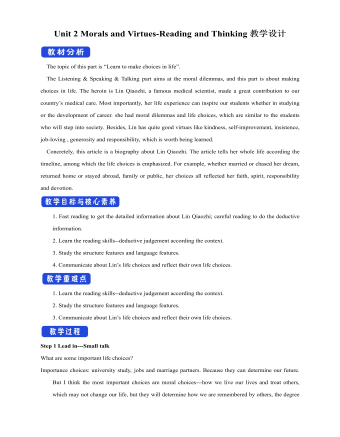
新人教版高中英语必修3Unit 2 Morals and Virtues-Reading and Thinking教学设计
The topic of this part is “Learn to make choices in life”.The Listening & Speaking & Talking part aims at the moral dilemmas, and this part is about making choices in life. The heroin is Lin Qiaozhi, a famous medical scientist, made a great contribution to our country’s medical care. Most importantly, her life experience can inspire our students whether in studying or the development of career. she had moral dilemmas and life choices, which are similar to the students who will step into society. Besides, Lin has quite good virtues like kindness, self-improvement, insistence, job-loving , generosity and responsibility, which is worth being learned.Concretely, this article is a biography about Lin Qiaozhi. The article tells her whole life according the timeline, among which the life choices is emphasized. For example, whether married or chased her dream, returned home or stayed abroad, family or public, her choices all reflected her faith, spirit, responsibility and devotion.1. Fast reading to get the detailed information about Lin Qiaozhi; careful reading to do the deductive information.2. Learn the reading skills--deductive judgement according the context.3. Study the structure features and language features. 4. Communicate about Lin’s life choices and reflect their own life choices.1. Learn the reading skills--deductive judgement according the context.2. Study the structure features and language features.3. Communicate about Lin’s life choices and reflect their own life choices.Step 1 Lead in---Small talkWhat are some important life choices?Importance choices: university study, jobs and marriage partners. Because they can determine our future.
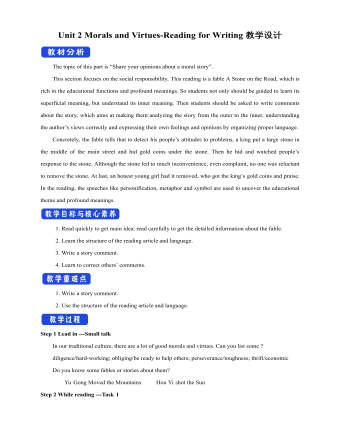
新人教版高中英语必修3Unit 2 Morals and Virtues-Reading for Writing教学设计
1. 这个寓言是一个关于一位国王古寓言。 The fable is an old fable about a king.2.作者用这个故事让读者对于社区的问题负有个人责任的必要印象深刻。The author used the story to impress upon readers with the need to take personal responsibility for problems in the community.3. 这个故事十分成功的实现了它的目的。The story was quite successful in achieving its purpose.Step 7 WritingPlease write a review of the story according the outline above.The fable is an old fable about a king who thought his people are lazy, so he put a large stone in the middle of the road and hides and waited to see if anyone will try to move it.The author used this story to impress upon readers with the need to take personal responsibility for problems in the community. The story was quite successful in achieving its purpose, and I liked it because it had a clear moral.However, while the moral of the story is clear, the actions of the king seemed pointless to me, because none of the characters in the story learnt anything. For this reason, I think there are better stories that can be used to impress upon people with the need for personal responsibility.Step 8 Pair workExchange drafts with a partner. Use this checklist to help your partner revise his/her draft.1. Does the writer give a short description of the story ?2. Does the description include the most important details of the story ?3. Does the writer give his or her opinion about the character or their actions ?4. Is the review well-organised ? 5. Does the writer use the -ing form as the adverbial correctly in the writing ?6. Are there any grammar, spelling, or punctuation errors ?Step 9 HomeworkPut up your revised draft in the classroom or read it to your class.

新人教版高中英语必修3Unit 4 Space Exploration-Listening&Speaking&Talking教学设计一
Listening and Speaking introduces the topic of “talking about how to become an astronaut”. This period is aimed to inform students some details about the requirements of being an astronaut. Students can be motivated and inspired by the astronauts. Teachers ought to encourage students to learn from them and let them aim high and dream big.Listening and Talking introduces the theme of "talk about life in space". This part also informs students more details about life in space and can inspire students to be curious about this job. 1. Guide students to listen for numbers concerning dates, years and ages etc2. Cultivate students' ability to talk about how to become an astronaut and life in space ; 3. Instruct students to use functional sentences of the dialogue such as “ first of all, I am not sure, so what might be .. I guess.. I wonder…I am curious…)appropriately.1. Guide students to understand the content of listening texts in terms of the whole and key details; 2. Cultivate students' ability to guess the meaning of words in listening; discuss with their peers how to become a qualified astronaut and describe the life in space.Part 1: Listening and SpeakingStep 1: Lead inPredictionThe teacher can ask students to predict what the listening text is about by looking at the pictures.About how to become an astronaut./the requirements of an astronautStep 2: Then, play the radio which is about an interview a. And after finishing listening for the first time, the students need to solve the following tasks.